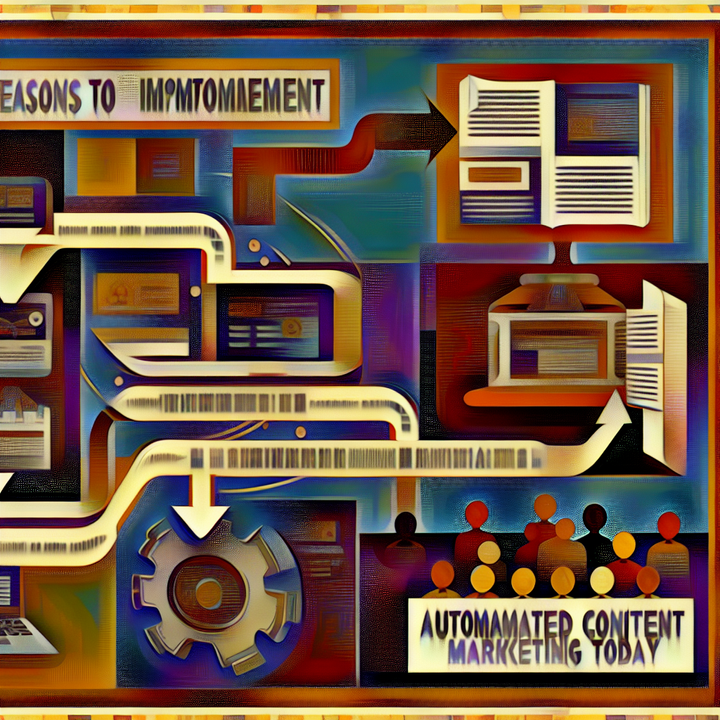Tracking and Analyzing Automated Content Performance

Welcome to the world of automated content performance—a vital element for any business aiming to thrive in today's digital landscape. Automation isn't just a buzzword; it's a game-changer, making content marketing more efficient and effective. This article explores automated content performance, highlighting why it’s essential for businesses and how performance tracking can lead to informed content strategies. Let's dive in!
Understanding Automated Content Performance
Automated content performance refers to the ability of automated systems to create, distribute, and analyze content such as blogs and newsletters, without manual intervention. For businesses, this means saving invaluable time and resources. When utilizing Taleflow's services, for example, companies see the advantage of having blogs and newsletters tailored to specific audiences, all while reducing the need for constant manual input.
Benefit analysis shows that:
- Automation saves time for content creators.
- Consistent and timely content releases keep audiences engaged.
- Specialization ensures content is highly relevant to the target audience.
Tracking and analyzing this automated content can significantly benefit the business by highlighting what works and what doesn't, allowing for data-driven decisions to optimize future efforts.
Key Metrics for Monitoring Automated Content
Understanding the performance of your automated content involves monitoring several key metrics. Here are essential ones to consider:
- Engagement Rates: Measures how actively your audience interacts with your content.
- Click-Through Rates (CTR): Tracks the percentage of people who click on links within your content.
- Conversion Rates: Indicates the percentage of users who take a desired action, such as signing up for a service or making a purchase.
- SEO Rankings: Reflects how well your content performs in search engines.
Each of these metrics offers insights into different aspects of content performance. For example, high engagement rates suggest that your content resonates well with your audience, while strong SEO rankings indicate that your content is discoverable and relevant to search queries.
Tools for Tracking Automated Content Performance
Monitoring the performance of automated content requires effective tools. Here are some that can provide comprehensive insights:
| Tool | Description |
|---|---|
| Google Analytics | A comprehensive tool for tracking website traffic and user behavior. |
| Ahrefs | Ideal for analyzing SEO performance and competitor insights. |
| SEMrush | Offers solutions for SEO, PPC, and content marketing metrics. |
| Taleflow Analytics | Specialized in tracking performance metrics specific to automated blogs and newsletters. |
Choosing the right tool depends on your specific needs, but integrating multiple tools can provide a more holistic view of your content performance.
Integrating Performance Tracking into Your Workflow
Incorporating performance tracking into your workflow need not be cumbersome. Here’s how different roles within an organization can seamlessly include this practice:
- Busy Business Owner: Use automated reports to get a quick snapshot of performance metrics weekly.
- Marketing Manager: Schedule bi-weekly deep dives into performance data to adjust strategies.
- Content Strategist: Integrate performance reviews into the content planning process.
- Startup Founder: Use simplified dashboards to track key metrics and make agile decisions.
Taleflow’s automated solution simplifies this by providing performance analytics directly within the platform, making it easy for any role to stay on top of content performance.
Analyzing Data to Inform Content Strategy
Once you've collected data, the next step is to analyze it to improve your content strategy. Key methods include:
“Your biggest asset is knowing your audience's behavior and preferences. Data shows you the way.”
By diving deep into metrics, you can uncover:
- Audience preferences: What type of content gets the most engagement?
- Optimal posting times: When is your audience most active?
- Successful topics: Which themes resonate most with your audience?
Case Study: A retail company used Taleflow’s analytics to discover that their audience was more engaged with how-to blog posts. By focusing efforts on this content type, they saw a 30% increase in engagement within three months.
Optimizing Automated Content for Better Results
Improving the effectiveness of your automated content often requires tweaks based on performance data. Here are some strategies:
- Update Keywords: Modify keywords based on trending topics and SEO performance.
- Modify Topics: Pivot towards content types that show higher engagement.
- Adjust Frequency: Find the sweet spot for posting frequency to maximize audience engagement without oversaturating it.
With Taleflow, these optimizations can be implemented automatically, ensuring continuous improvements with minimal effort.
Overcoming Common Challenges in Content Performance Reporting
Tracking and analyzing content performance isn't without its challenges. Here are common hurdles and how to overcome them:
- Data Accuracy: Ensure all tracking tools are correctly integrated and calibrated.
- Attribution Issues: Use multi-touch attribution models to better understand user journeys.
- Metric Interpretation: Regularly review and update your key performance indicators (KPIs).
Taleflow minimizes these issues by offering accurate, real-time data collection and user-friendly dashboards that make interpreting metrics straightforward.
Utilizing Reports to Demonstrate ROI
Performance reports are invaluable for demonstrating the ROI of your content marketing efforts. Here’s how to present them effectively:
- Clear Templates: Use consistent and easy-to-read templates for all reports.
- Visual Aids: Incorporate graphs and charts to illustrate key metrics.
- Comparative Data: Show performance over different periods to highlight growth.
With Taleflow, you can generate tailored reports that clearly showcase your content’s impact, making it easier to communicate successes to stakeholders.
Maintaining Continuous Improvement
Adopting a mindset of continuous improvement is crucial for sustained success in content marketing. Key practices include:
- Regular Monitoring: Keep track of performance metrics on a consistent basis.
- Stay Updated: Follow industry trends to adapt strategies as needed.
- Data-Driven Adjustments: Use your performance data to make informed decisions.
Taleflow supports this ongoing process by providing continuous updates and insights, ensuring your content strategies remain ahead of the curve.
In conclusion, performance tracking of automated content is a cornerstone of modern content marketing strategies. By understanding key metrics, using the right tools, and integrating tracking into your workflow, businesses can make data-driven decisions that lead to heightened engagement and better ROI. Taleflow's automated solution streamlines this process, making it easier than ever to optimize your content marketing efforts.



